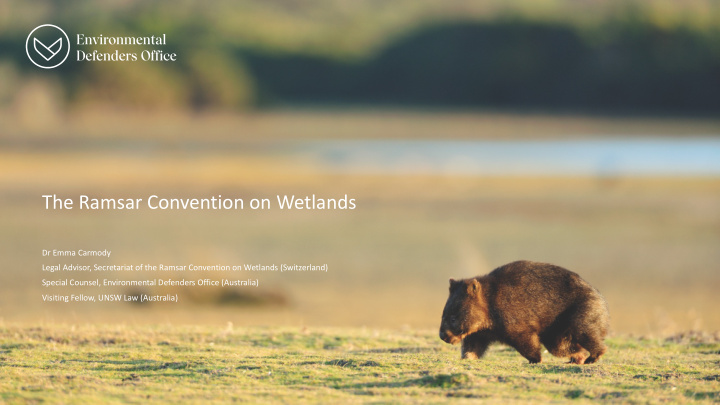



The Ramsar Convention on Wetlands Dr Emma Carmody Legal Advisor, Secretariat of the Ramsar Convention on Wetlands (Switzerland) Special Counsel, Environmental Defenders Office (Australia) Visiting Fellow, UNSW Law (Australia)
1. Ramsar Convention on Wetlands – history, governance, law 2. The role of legal advisor to the Ramsar Convention on Wetlands 3. Ramsar Convention on Wetlands and SDGs Subhead or explanation here
1. History, Governance, Law
HISTORY Oldest MEA • Adopted in 1971 and entered into force in 1975 • 1971 – 18 signatories • 1974 – Australia designated first wetland: Coburg Peninsula in NT • 2020 – 171 signatories • Provides for the listing and conservation of wetlands of international • importance and ‘wise use’ of all wetlands in territory of signatory state
Extent of Ramsar listed Wetlands Number of sites: 2390 Extent: 253,875,627 ha Global distribution: • Africa 394 • Asia 329 • Latin Am 201 • Oceania 82
Governance • COP • Standing Committee • Scientific and Technical Review Panel • Other subsidiary bodies • Secretariat
What’s the law got to do with it?
Graph of doom
2. Legal advisor • Advise during sessions of COP and SC • Advise intersessionally
3. SDGs and the future of the Convention i. ‘Wise use’ concept ii. Case study – Ngiri-Tumba Maindombe wetlands iii. Ramsar and SDG 6 iv. Future of the Convention
i. SDGs and concept of ‘wise use’ Article 3.1 ...the maintenance of their ecological The Contracting Parties shall formulate character, achieved through the and implement their planning so as to implementation of ecosystem promote the conservation of the approaches, within the context of wetlands included in the List, and as far sustainable development. as possible the wise use of wetlands in their territory. COP 9, Resolution IX.1, Annex A
ii. Ngiri-Tumba-Maindombe in the Democratic Republic of Congo – 65,000 km² Plagued by: • Legacy of civil water and ongoing, intermittent internal conflict • Widespread poverty (63 percent of the population lives below the poverty line) • Widespread food insecurity and malnutrition • Lack of access to clean water • High infant and maternal mortality rates
Ngiri-Tumba-Maindombe and SDGs continued… The rivers and lakes of the region are a major storehouse for CO2 (SDG 13) The wetland’s vegetation protects towns along the Congo River from floods (SDG 11) Forests filter water and maintain its quality for human consumption (SDG 6) Vital for food security - cassava, fish etc. (SDG 2) Lake Tumba supports over 114 species of fish (SDG 2, 15)
iii. Ramsar Convention on Wetlands and SDG 6 SDG 6 – Clean Water and Sanitation SDG Target 6.1 – By 2020, protect and restore water-related ecosystems, including mountains, forests, wetlands, Ramsar: co-custodian of rivers, aquifers and lakes. SDG Indicator 6.6.1 SDG Indicator 6.6.1 – Map the following: • Spatial extent of water-related ecosystems and inland open waters • Quantity of water in ecosystems • Quality of water in ecosystems
iv. SDGs and the future of the Ramsar Convention Food security (SDG 2) • Fisheries, agriculture • Chilika Lake in Odisha, India – sustains 200,000 fisherfolk Sustainable use of water and sanitation (SDG 6) • In 2009, Wetlands International reported that work in four major wetlands demonstrated strong link between water quality and quantity in wetlands and health of wetland- dependent communities Climate change (SDG 13) • Carbon sequestration and storage • Contain 35% of global terrestrial carbon • Clearing can release Co2
Final observations… • Wetlands cover 6-9% Earth’s surface – many in Global South • What is needed: • Educate re. links to SDGs in particular food security, water security and climate change • Elevate status of Convention internationally • Greater integration with work of UN bodies (UNGA, ECOSOC…) • Improved implementation
www.ramsar.org
Recommend
More recommend